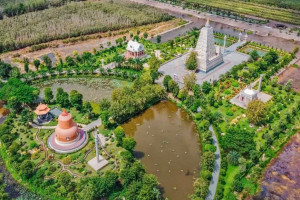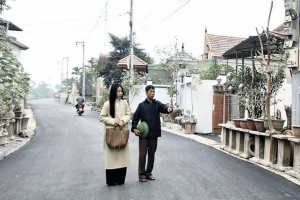
In early 1920s, a number of civil servants in Saigon gathered together to learn and study the teachings of the three religions: Buddhism - Taoism - Confucianism. Mr. Âu Kiệt Lâm, with religious alias as Minh Chánh, and some friends bought books French to research on the human energy system.
Then he developed his faith in the divine, learnt to contact with divine spirits by divine channeling, and later received blessings from them and their instructions in order to attain enlightenment. By 1924, Mr Âu Kiệt Lâm and his friends became enlightened and given guidance from the divine to establish a religion named Minh Ly religion. According to this religion ‘Minh’ means enlightenment of the Great Way, thus contributing to propagate virtues of this Great Way; ‘Ly’ stands for in-dept understanding, thus contributing to create direct conversations and speaking of ethics by powerful words. Altogether Minh Ly religion means enlightenment of the reasoning of the Way.
Founding dignitaries of Minh Ly religion included Mr. Âu Kiệt Lâm or Minh Chánh in religious name, Mr. Nguyễn Văn Xưng or Minh Giáo as religious name, Mr. Nguyễn Văn Đề or Minh Đạo, Mr. Lê Văn Ngọc or Minh Truyền, Mr. Nguyễn Văn Miết or Minh Thiện, and Mr. Võ Văn Thạnh or Minh Trực.
In the period from September 1925 to February 1927, Minh Ly religion took up Linh Son pagoda in Co Giang street as a temporary venue for religious activities on 14th and 30th of every lunar month. During this period, in order to create a place for worshipping the divine, dignitaries of Minh Ly religion made efforts to build a temple and was given a name for this temple as Tam Tong Mieu (Temple of Three Sects) by Dieu Tri Divine Mother. With donations of land and funding and other supports from religious devotees, Minh Ly religion held a ground-breaking ceremony for its first temple on September 9, 1926. On February 2, 1927, Tam Tong Mieu was officially inaugurated. This temple has been restored and upgraded twice, in 1941 and 1957. Currently Tam Tong Mieu is located at No 82, Cao Thang str, Ward 4, District 3, Ho Chi Minh City.
After three years since its founding, the number of converts grew up, so leading dignitaries of Minh Ly religion submitted an application to the government of that time for a formal recognition. At the same time Minh Ly religion collected and compiled scriptures from given materials and printed copies of these scriptures for favor of free distribution to devotees and those interested in the religion. Further materials were also dictated by the divine spirits for improving systems of religious liturgy, rites and ways to establishing worshipping altars.
In yearly years of development history of Minh Ly religion, six founding dignitaries have created and improved the religious internal structure by systems of religious administrative organizations, dignitaries, devotees, doctrine, tenets, canon law, scriptures…
From 1941 to 1965, Minh Ly religion experienced a period of challenge for its development and or even its existence. Some of converts were unable to keep perseverance with the religion, and even the religion itself was at a risk of falling to pieces. However, those persevering with the religion determined to stay with the religion, maintain self-practices, and keep regular worshiping activities at Tam Tong Mieu. Founding member Nguyễn Văn Miết (or Minh Thiện) in charge of religious existence at that time renounced his earthy life for total dedication to the religion. He devoted his time for compiling divine scriptures, writing books translating sacred teachings and restoration of Tam Tong Temple, planning to build Bat Nha monastery, and instructing the faithful to conduct religious activities in lines with orthodox teachings of Minh Ly religion. In particular, Reverent Minh Thien compiled a book of Minh Ly’s fundamental teachings, called Minh Ly Tenets, for believers to follow and practice.
The period from 1965 to 1975 was regarded as a stage of development and expansion, marked by the establishment of the Sacerdotal Council, a more comprehensive system of internal administration and a set of scriptures entitled Minh Ly Explanation of the Truth supplementary to the book Minh Ly Tenets compiled earlier.
After the unification of the country, Minh Ly religion continued to relentlessly consolidate itself by keeping fundamental teachings of the three religions of Buddhism, Taoism and Confucianism, promoting religious understanding and tolerance that contribute to its peaceful coexistence with other beliefs or religions. Minh Ly religion also attached its importance to humanitarian activities and social engagement, contributing to live for “better secular and religious life”.
Currently Minh Ly religion has more than 1000 members residing mostly in provinces of Long An, Ba Ria – Vung Tau and Ho Chi Minh City; Reverent Lê Chơn Huệ, relgious alias as Tường Định, has been nominated as Chief of Minh Ly religion.
Teachings of Minh Ly religion combine the essence of the three major Eastern religions of Buddhism, Taoism and Confucianism into one system of teachings. From doctrines and fundamental concepts and teachings of Buddhism, Taoism and Confucianism, Minh Ly religion develops and creates scriptures for its own tenets, cannon laws and rites, making easy access and convenient use for its followers. Minh Ly religious tenets embody three basic principles. The first one is the integration of three religions into one system where moral, body self-practicing and mind self-developing are three necessary measures for a religious life of Minh Ly religion. The second one is to trace the three religions back to the one and the same source: Three different religions originating from one and single source and serving the sole purpose of spiritual uplifting to full self-realization. The last principle is to uphold the real self, which is the God or Buddhist nature. Teachings system of Minh Ly religion is also divided into various degrees of understanding and practices to suit different capacities of its practitioners.
Minh Ly scriptures have been written in Vietnamese, making it easy to read, understand and learn by hearts. The system of Minh Ly scriptures are divided into five sets according to purposes of general introduction, practice of repentance, dissolution of karma, daily practices, and general understanding for practitioners. Some of Minh Ly writings have been used by Cao Dai religion that was formed two years after the founding of Minh Ly religion. There are also books of cannon laws, such as Precepts and Disciplines; Four Important Vows and Twenty-four Precepts… Besides, there are analytic books, including Minh Ly Explanation, Minh Ly Doctrines and Minh Ly Interpretation of the Truth…
Minh Ly religion uses tablets of names of worshipping figures instead of statues of them in worshipping temples. In temples of Minh Ly religion, altars are arranged in five levels. Worshipping figures in tablets includes: God the Creator; Dieu Tri Divine Mother; Patriarchs of Three Religions (Shakyamuni Buddha who represents Buddhism, Lao Tse who represents Taoism, Confucius who represents Confucianism); Bodhisattva Ksitigarbha, Bodhisattva Manjushri, the Bodhisattva Samantabhadra, Avalokitesvara Bodhisattva.
Minh Ly dressings use black and white colors. Religious men wear white trousers and long black shirt, with black calf. Religious women use all black dresses.
The administrative structure of Minh Ly religion includes the Sacerdotal Council as the central management body and two other agencies in charge of religious practices and internal administrative affairs respectively.
Religious personnel of Minh Ly religion, from newly converts to religious masters, are divided in eight ranks of members. A dignitary of Minh Ly religion has to be vegetarian at least six days monthly and observe ten important precepts, while the high-ranking dignitaries have to detach themselves from the mundane and observe additional precepts./.
Tri An




